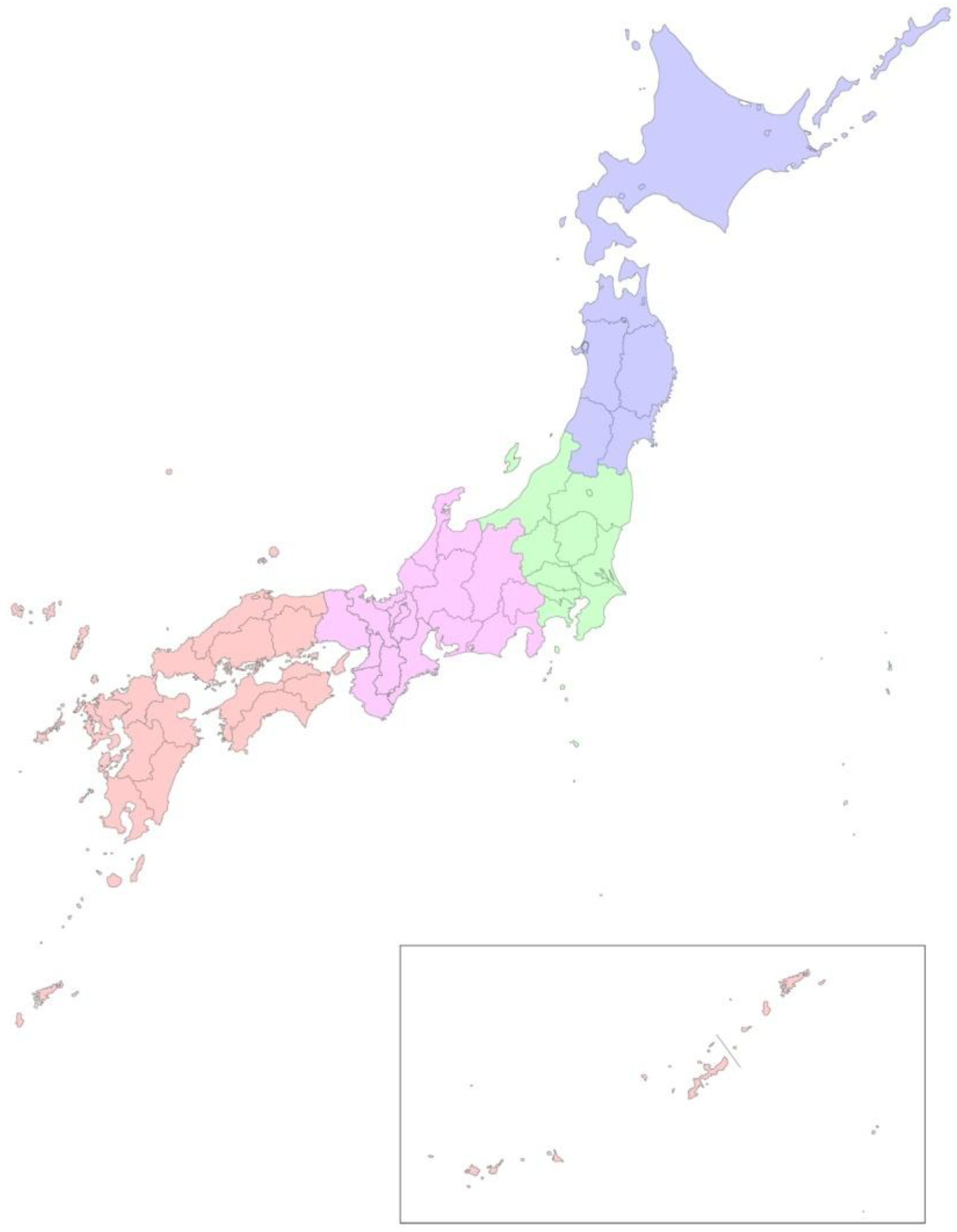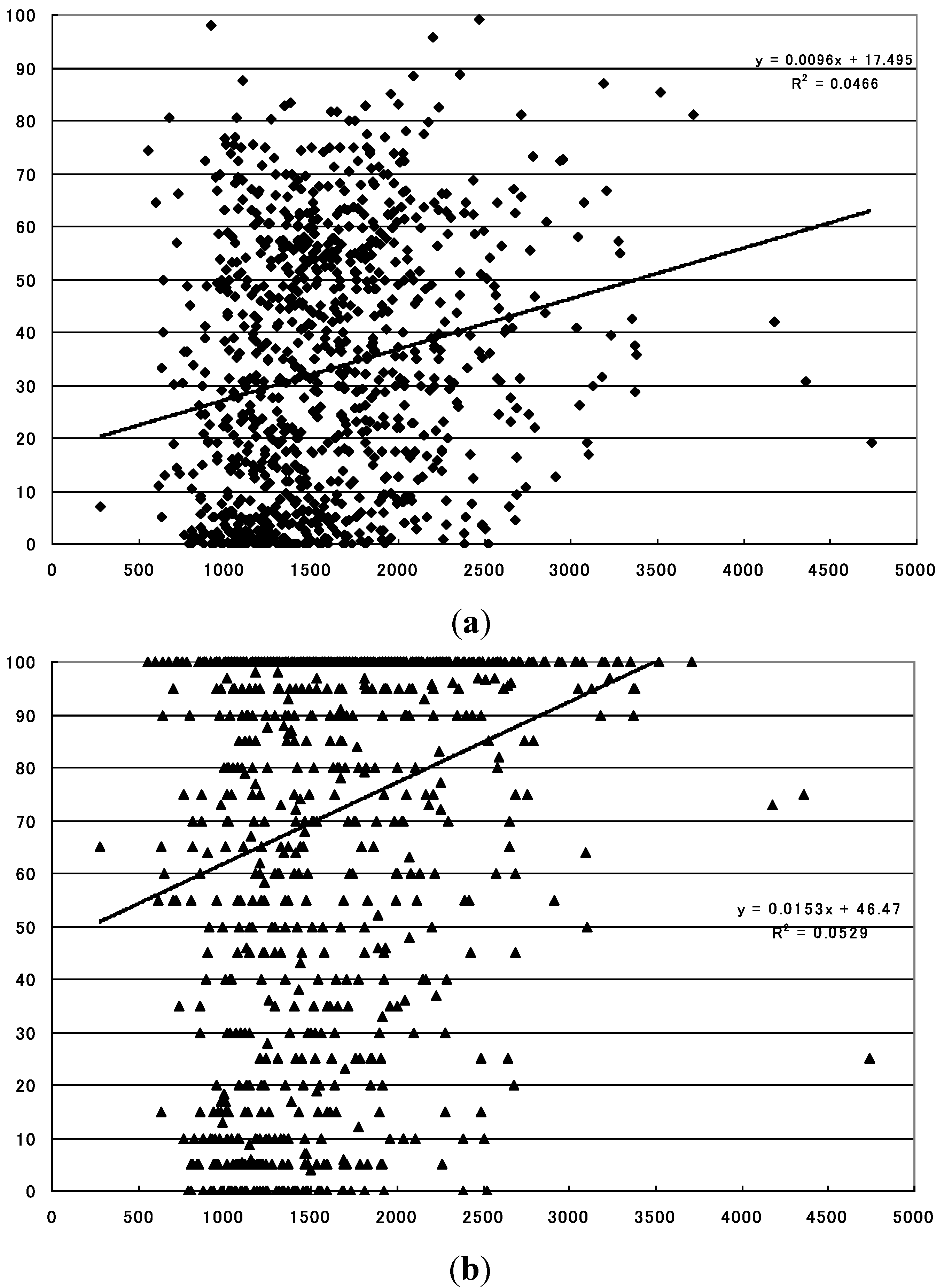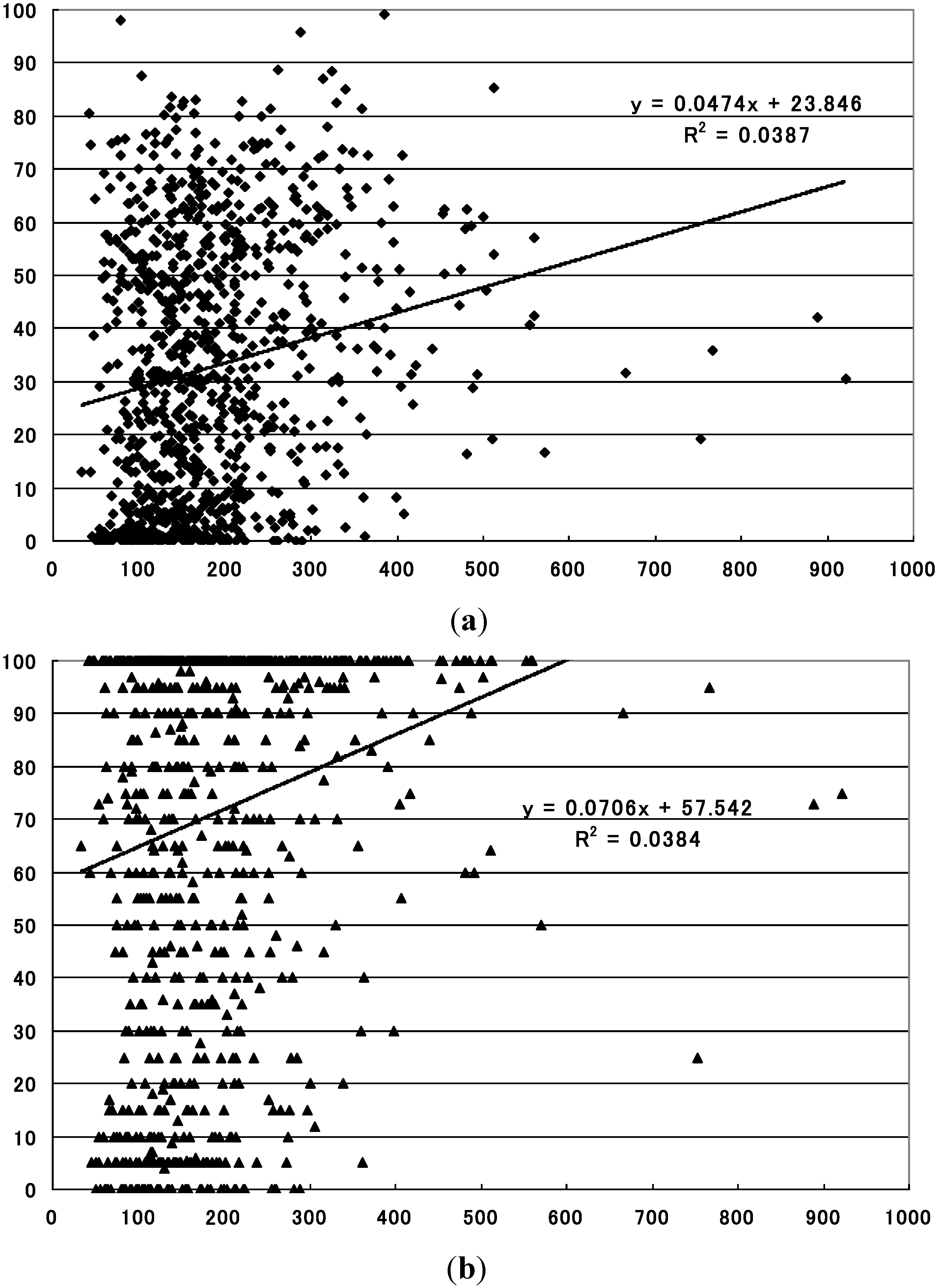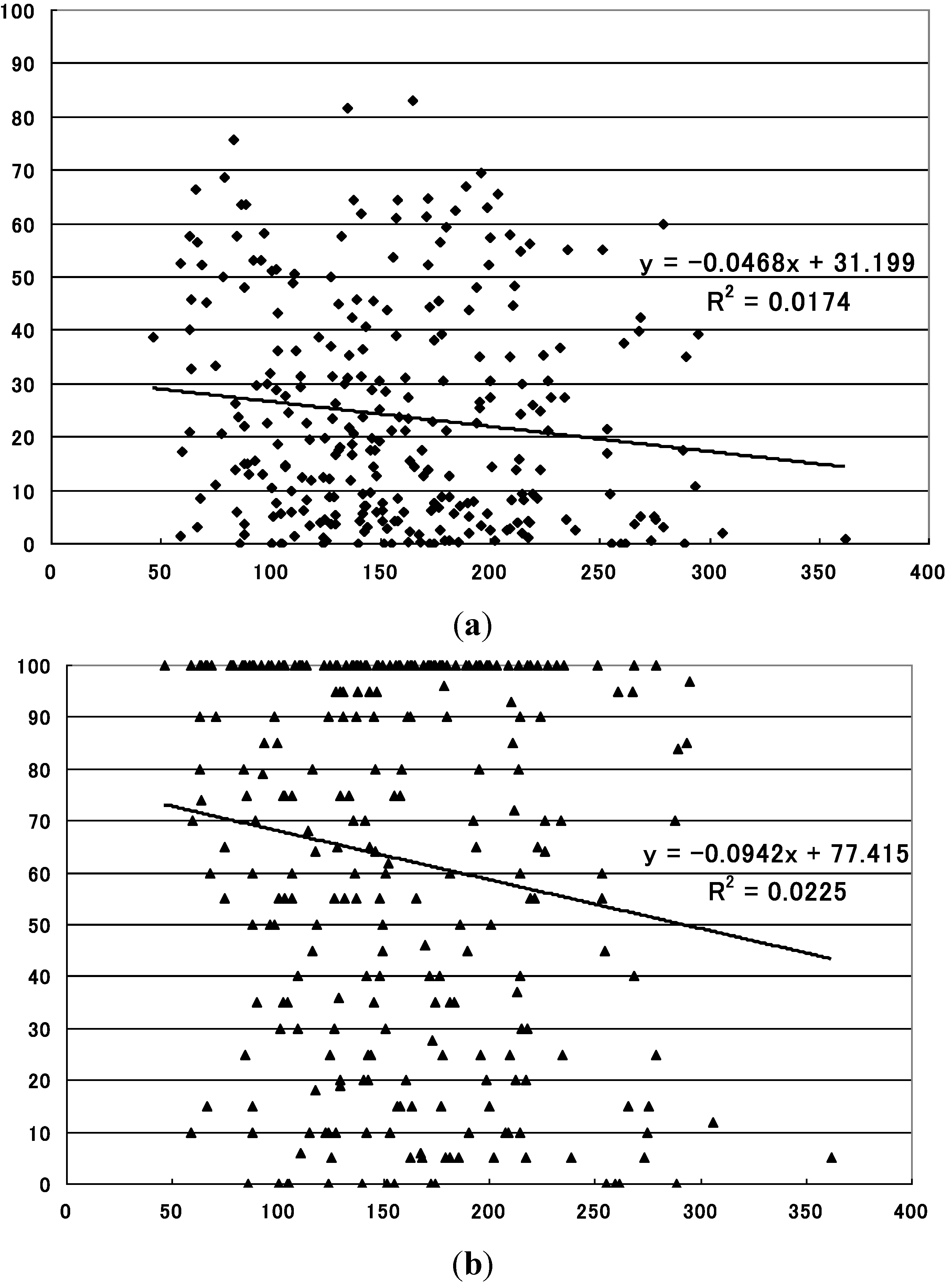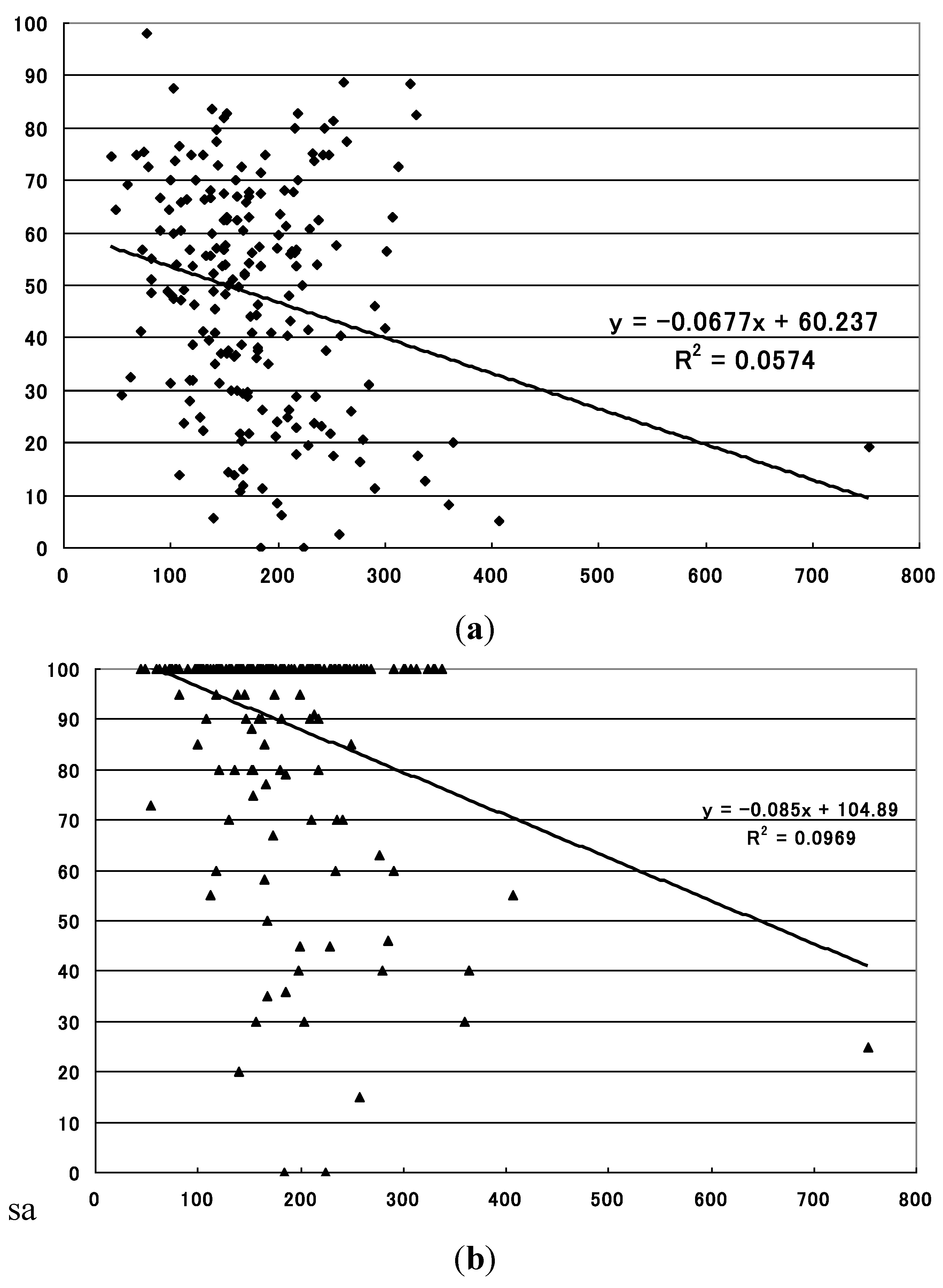3.1. The Relationship between the Annual Precipitation and Sero-Conversion Rate in Sentinel Pigs
The relationship was analyzed between the annual precipitation and the levels of antibody-positive rates. Two types of the sero-conversion data were used: the mean and the maximum sero-conversion rates in respective years. The relationships were analyzed for the whole of Japan, and for each of the four regions shown in
Figure 1 (
Table 1).
Table 1.
Relationship between the annual and summertime precipitation and sero-conversion rate to JE virus in sentinel pigs.
Table 1.
Relationship between the annual and summertime precipitation and sero-conversion rate to JE virus in sentinel pigs.
| Periods and Regions | Sample Number | Mean HI positivity | Maximum HI positivity |
|---|
| Inclination | R2 | p | Inclination | R2 | p |
|---|
| Year-round |
| Entire Japan | 947 | 0.0096 | 0.0446 | 1.899 × 10−11 | 0.0153 | 0.0529 | 7.790 × 10−13 |
| Region 1 (North) | 167 | 0.0070 | 0.0223 | 0.054 | 0.0188 | 0.0250 | 0.041 |
| Region 2 (Central) | 280 | 0.0031 | 0.0069 | 0.166 | 0.0053 | 0.0065 | 0.179 |
| Region 3 (West) | 199 | −0.0061 | 0.0154 | 0.081 | −0.0094 | 0.0399 | 0.005 |
| Region 4 (South) | 301 | 0.0045 | 0.0183 | 0.019 | 0.0027 | 0.0063 | 0.170 |
| June, July and August |
| Entire Japan | 941 | 0.0474 | 0.0387 | 1.156 × 10−9 | 0.0706 | 0.0384 | 1.344 × 10−9 |
| Region1 (North) | 165 | 0.0009 | 0.00001 | 0.968 | 0.0229 | 0.0012 | 0.659 |
| Region 2 (Central) | 279 | −0.0468 | 0.0174 | 0.028 | −0.0942 | 0.0225 | 0.012 |
| Region 3 (West) | 197 | −0.0677 | 0.0574 | 0.001 | −0.0850 | 0.0969 | 8.490 × 10−6 |
| Region 4 (South) | 300 | 0.0137 | 0.0078 | 0.127 | 0.0061 | 0.0014 | 0.519 |
The levels of the annual precipitation demonstrated statistically significant positive correlations with both the mean and maximum sero-conversion rates for the whole of the country (
p = 1.899 × 10
−11 with the mean sero-conversion rate, and
p = 7.790 × 10
−13 with the maximum sero-conversion rate) (
Figure 2). The levels of annual precipitation also demonstrated statistically significant positive correlations with the mean sero-conversion rates for region 4 (
p = 0.019), and with the maximum sero-conversion rate for region 1 (
p = 0.041) (
Table 1). On the other hand, the levels of the annual precipitation demonstrated statistically significant inverse correlations with the maximum sero-conversion rate for region 3 (
p = 0.005).
Figure 2.
Relationship between annual precipitation and sero-conversion rate to JE virus in sentinel pigs in the whole of Japan. (a) Statistically significant positive relationship with the mean sero-conversion rate (p = 1.899 × 10−11).X-axis: precipitation during the period (mm), Y-axis: sero-conversion rate to JE virus (%); (b) Statistically significant positive relationship with the maximum sero-conversion rate (p = 7.790 × 10−13). X-axis: precipitation during the period (mm), Y-axis: sero-conversion rate to JE virus (%).
Figure 2.
Relationship between annual precipitation and sero-conversion rate to JE virus in sentinel pigs in the whole of Japan. (a) Statistically significant positive relationship with the mean sero-conversion rate (p = 1.899 × 10−11).X-axis: precipitation during the period (mm), Y-axis: sero-conversion rate to JE virus (%); (b) Statistically significant positive relationship with the maximum sero-conversion rate (p = 7.790 × 10−13). X-axis: precipitation during the period (mm), Y-axis: sero-conversion rate to JE virus (%).
3.2. The Relationship between the Summertime Precipitation and Sero-Conversion Rate in Sentinel Pigs
The levels of the summertime precipitation demonstrated statistically significant positive correlations with both the mean and maximum sero-conversion rates for the whole of Japan (
p = 1.156 × 10
−9 with the mean sero-conversion rate, and
p = 1.344 × 10
−9 with the maximum sero-conversion rate) (
Table 1,
Figure 3).
Figure 3.
Relationship between summertime precipitation and sero-conversion rate to JE virus in sentinel pigs in the whole of Japan. (a) Statistically significant positive relationship with the mean sero-conversion rate (p = 1.156 × 10−9). X-axis: precipitation during the period (mm), Y-axis: sero-conversion rate to JE virus (%); (b) Statistically significant positive relationship with the maximum sero-conversion rate (p = 1.344 × 10−9). X-axis: precipitation during the period (mm), Y-axis: sero-conversion rate to JE virus (%).
Figure 3.
Relationship between summertime precipitation and sero-conversion rate to JE virus in sentinel pigs in the whole of Japan. (a) Statistically significant positive relationship with the mean sero-conversion rate (p = 1.156 × 10−9). X-axis: precipitation during the period (mm), Y-axis: sero-conversion rate to JE virus (%); (b) Statistically significant positive relationship with the maximum sero-conversion rate (p = 1.344 × 10−9). X-axis: precipitation during the period (mm), Y-axis: sero-conversion rate to JE virus (%).
Figure 4.
Relationship between summertime precipitation and sero-conversion rate to JE virus in sentinel pigs in the region 2 (central region). (a) Statistically significant inverse relationship with the mean sero-conversion rate (p = 0.028). X-axis: precipitation during the period (mm), Y-axis: sero-conversion rate to JE virus (%); (b) Statistically significant inverse relationship with the maximum sero-conversion rate (p = 0.012). X-axis: precipitation during the period (mm), Y-axis: sero-conversion rate to JE virus (%).
Figure 4.
Relationship between summertime precipitation and sero-conversion rate to JE virus in sentinel pigs in the region 2 (central region). (a) Statistically significant inverse relationship with the mean sero-conversion rate (p = 0.028). X-axis: precipitation during the period (mm), Y-axis: sero-conversion rate to JE virus (%); (b) Statistically significant inverse relationship with the maximum sero-conversion rate (p = 0.012). X-axis: precipitation during the period (mm), Y-axis: sero-conversion rate to JE virus (%).
The levels of the summertime precipitation, on the other hand, demonstrated statistically significant inverse correlations with the mean sero-conversion rates for region 2 (
p = 0.028) and region 3 (
p = 0.001), and with the maximum sero-conversion rate for region 2 (
p = 0.012) and for region 3 (
p = 8.490 × 10
−6) (
Table 1,
Figure 4,
Figure 5).
Figure 5.
Relationship between summertime precipitation and sero-conversion rate to JE virus in sentinel pigs in the region 3 (west region). (a) Statistically significant inverse relationship with the mean sero-conversion rate (p = 0.001). X-axis: precipitation during the period (mm), Y-axis: sero-conversion rate to JE virus (%); (b) Statistically significant inverse relationship with the maximum sero-conversion rate (p = 8.490 × 10−6). X-axis: precipitation during the period (mm), Y-axis: sero-conversion rate to JE virus (%).
Figure 5.
Relationship between summertime precipitation and sero-conversion rate to JE virus in sentinel pigs in the region 3 (west region). (a) Statistically significant inverse relationship with the mean sero-conversion rate (p = 0.001). X-axis: precipitation during the period (mm), Y-axis: sero-conversion rate to JE virus (%); (b) Statistically significant inverse relationship with the maximum sero-conversion rate (p = 8.490 × 10−6). X-axis: precipitation during the period (mm), Y-axis: sero-conversion rate to JE virus (%).
3.3. The Effect of the Precipitation during Previous Days on the Sero-Conversion Rate to JE Virus in Pigs
We determined whether the levels of precipitation during preceding days before blood collection have any effect on the sero-conversion rate. The relationship was analyzed between the maximum sero-conversion rate in sentinel pigs and the levels of rainfall during preceding 10-day periods from days 1–50 before blood collection (
Table 2).
Table 2.
Effect of the precipitation during preceding 10-day periods from day 1 to day 50 before blood collection on the maximum sero-conversion rate to JE virus in sentinel pigs.
Table 2.
Effect of the precipitation during preceding 10-day periods from day 1 to day 50 before blood collection on the maximum sero-conversion rate to JE virus in sentinel pigs.
| Period | Sample Number | Inclination | R2 | p |
|---|
| 1–10 days |
| Entire Japan | 6,580 | −0.2876 | 0.0026 | 3.502 × 10−5 |
| Region1 (North) | 879 | 0.5632 | 0.0148 | 3.002 × 10−4 |
| Region 2 (Central) | 2,078 | 0.1385 | 0.0006 | 0.264 |
| Region 3 (West) | 1,599 | −0.9662 | 0.0191 | 2.878 × 10−8 |
| Region 4 (South) | 2,024 | −0.6188 | 0.0191 | 4.273 × 10−10 |
| 11–20 days |
| Entire Japan | 6,590 | −0.4262 | 0.0059 | 4.279 × 10−10 |
| Region1 (North) | 882 | 0.4695 | 0.0110 | 0.002 |
| Region 2 (Central) | 2,080 | −0.3444 | 0.0033 | 0.009 |
| Region 3 (West) | 1,599 | −1.4403 | 0.0409 | 3.210 × 10−16 |
| Region 4 (South) | 2,029 | −0.5990 | 0.0188 | 5.586 × 10−10 |
| 21–30 days |
| Entire Japan | 6,593 | −0.3330 | 0.0037 | 7.706 × 10−7 |
| Region1 (North) | 886 | 0.2694 | 0.0031 | 0.098 |
| Region 2 (Central) | 2,079 | −0.7207 | 0.0142 | 5.050 × 10−8 |
| Region 3 (West) | 1,598 | −1.4713 | 0.0414 | 2.150 × 10−16 |
| Region 4 (South) | 2,030 | −0.3450 | 0.0068 | 1.997 × 10−4 |
| 31–40 days |
| Entire Japan | 6,588 | −0.0570 | 0.0001 | 0.417 |
| Region1 (North) | 883 | 0.3161 | 0.0038 | 0.067 |
| Region 2 (Central) | 2,069 | −0.3561 | 0.0031 | 0.011 |
| Region 3 (West) | 1,605 | −1.0472 | 0.0210 | 5.480 × 10−9 |
| Region 4 (South) | 2,031 | −0.1814 | 0.0017 | 0.063 |
| 41–50 days |
| Entire Japan | 6,596 | 0.4577 | 0.0063 | 1.080 × 10−10 |
| Region1 (North) | 885 | 0.2640 | 0.0023 | 0.154 |
| Region 2 (Central) | 2,090 | −0.0575 | 0.0001 | 0.683 |
| Region 3 (West) | 1,604 | −0.2592 | 0.0012 | 0.166 |
| Region 4 (South) | 2,017 | 0.3596 | 0.0065 | 2.895 × 10−4 |
The levels of precipitation during preceding days demonstrated statistically significant inverse correlations with sero-conversion rates during preceding days 1–10 for the whole of Japan (p = 3.502 × 10−5), region 3 (p = 2.878 × 10−8) and region 4 (p = 4.273 × 10−10), during preceding days 11–20 for the whole of Japan (p = 4.279 × 10−10), region 2 (p = 0.009), region 3 (p = 3.210 × 10−16) and region 4 (p = 5.586 × 10−10), during preceding days 21–30 for the whole of Japan (p = 7.706 × 10−7), region 2 (p = 5.050 × 10−8), region 3 (p = 2.150 × 10−16) and region 4 (p = 1.997 × 10−4), and during preceding days 31–40 for region 2 (p = 0.011) and region 3 (p = 5.480 × 10−9). On the other hand, the levels of precipitation demonstrated statistically significant positive correlations with sero-conversion rates during preceding days 1–10 for region 1 (p = 3.002 × 10−4), during preceding days 11–20 for region 1 (p = 0.002), and during preceding days 41–50 for region 4 (p = 2.895 × 10−4).
3.4. Discussion
The effect of precipitation on the sero-conversion rate to JE virus in sentinel pigs was examined. As the meteorological parameter, we used: (i) the annual precipitation; (ii) the precipitation during summertime (June, July and August). The data on percent antibody-positive rates were used from 1969 to 2000, because high levels of sero-conversion to JE virus were constantly detected during this period. The results suggest that the relationship between the annual and summertime precipitation, and the sero-conversion rate to JE virus is complex; there were statistically significant positive correlations in the whole of country and in some of the regions; and there were also statistically significant inverse correlation in other regions.
Pigs are a natural host and the amplifier of JE virus in the JE virus transmission cycle in nature [
7]. In Japan, the vector mosquitoes begin to be detected in May [
9]. Sero-conversion of sentinel pigs then occur and the occurrence of human JE cases follows. The principal vector of JE virus in east Asia, including Japan, is
Culex tritaeniorhynchus [
8,
10], which reproduces in rice paddies and the connecting canals. It prefers the blood of middle to large-sized domestic or wild animals and that of humans. It is active in twilight and bites outdoors. It was reported that there was a positive relationship between the number of mosquitoes and that of JE cases [
11]. The complex effect of precipitation on the antibody-positive rate in pigs may be in part due to positive and negative effects of precipitation on life-cycle of the vector mosquito. Certain levels of precipitation are needed to maintain water enough for survival of larvae. High levels of rainfalls for short period of time may washout the larvae, thus, decrease the number of mosquitoes in the area.
The life cycle of Culex tritaeniorhynchus includes 2 days of egg period, 8–10 days of larva period and 1–2 days of pupa period, making a total of 11–14 days. Furthermore, it takes 10–12 days for the mosquito which bit the infected pigs to become able to transmit the virus to naïve pigs. It will also take 5–7 days for the infected pig develop specific antibody to JE virus. The calculation, on one hand, makes the results reasonable that the levels of rainfall during previous 10–40 days may wash out larvae, and demonstrate inverse correlation with antibody-positive rate in some regions. It is, however, difficult to explain positive correlations in other regions. The pattern of rainfalls may have undefined effects on the antibody-positive rates to JEV. Further studies are needed to determine the discrepancies of the results.
It has been reported that climate change has effects on arboviral diseases [
1,
2,
3]. There have been reports on the effect of climate change on JE [
12,
13]. In those papers, the number of JE cases was used for analyses. The number of JE patients is affected by multiple factors, such as antibody-positive rate in the population, levels of vaccine implementation, distributions of rice paddies and pig farms, life-style and social infrastructure, and JE virus virulence, as well as climate changes. Even though the level of the activity of JE virus-infected mosquitoes has increased, the number of JE patients has not increased in the countries where most of the populations have protective immunity against JE virus. Thus, the number of JE cases may not directly reflect the activity of JE virus in the countries, including Japan, where JE vaccination has been widely implemented. Pigs are slaughtered to be shipped to the market before 6 months of age, and the pigs present in May and following months were born after the JE season ended in previous year. They are naïve to JE virus when the new epidemic season starts in the next year. Naïve pigs are susceptible to JE virus, and develop high levels of viremia and specific antibody after infection with JE virus. Pigs are not immunized with JE vaccine Japan. Sero-conversion rates to JE virus among sentinel pigs most directly reflect JE virus activity in the region. Thus, the sero-conversion rate in sentinel pigs, the parameter which is assumed to directly reflect the activity of JE virus, has advantage over the number of JE patients. Furthermore, there have been dramatic changes in rice-growing practices such as mechanization, introduction and withdrawal of insecticides, introduction of growth suppressant and bactericides. These factors also could affect the sero-conversion rates through the effect on the number of mosquitoes.
There have also been reports on the effect of climate factors on vector mosquitoes for JE virus [
14,
15]. The number of vector mosquitoes is one of the important parameters which affect the epidemic of JE [
16]. The present study focused only on the effect of precipitation. We have reported that there were statistically significant positive correlations between sero-conversion rates to JE virus in sentinel pigs, and the daily mean temperatures, the daily maximum and the daily minimum temperatures of the entire year and summertime in the whole country and in the four (north, central, west and south) regions of Japan (Kurane
et al., submitted manuscript). There is a possibility that the temperature may be lower when there are higher levels of precipitation. Thus, low temperature during the period with high levels of precipitation may in part contribute to inverse correlation between the levels of precipitation and antibody-positive rate in sentinel pigs. The combined effect of precipitation and temperature is an important subject of research, and needs to be analyzed in the next series of studies.
These results suggest that the relationship between the precipitation and the sero-conversion rate to JE virus is complex. It is possible that not only the levels of precipitation during the designated time period, but also the patterns of rainfall may determine the effects. The effect may be different even with the same levels of precipitation during the designated period between heavy rain for short period of time and low levels of constant rainfall. We could not analyze the rainfall patterns in the present study. Further studies on the effect of the patterns of rainfall and on the combined effects of multiple meteorological parameters are needed.
